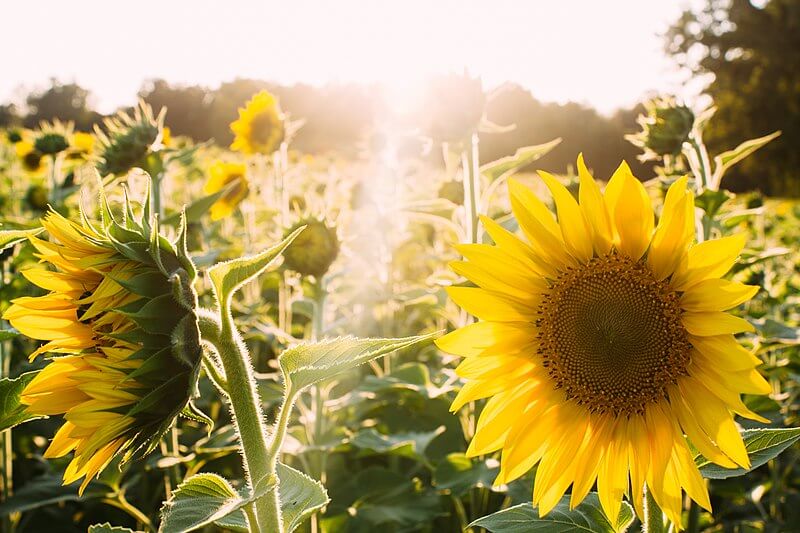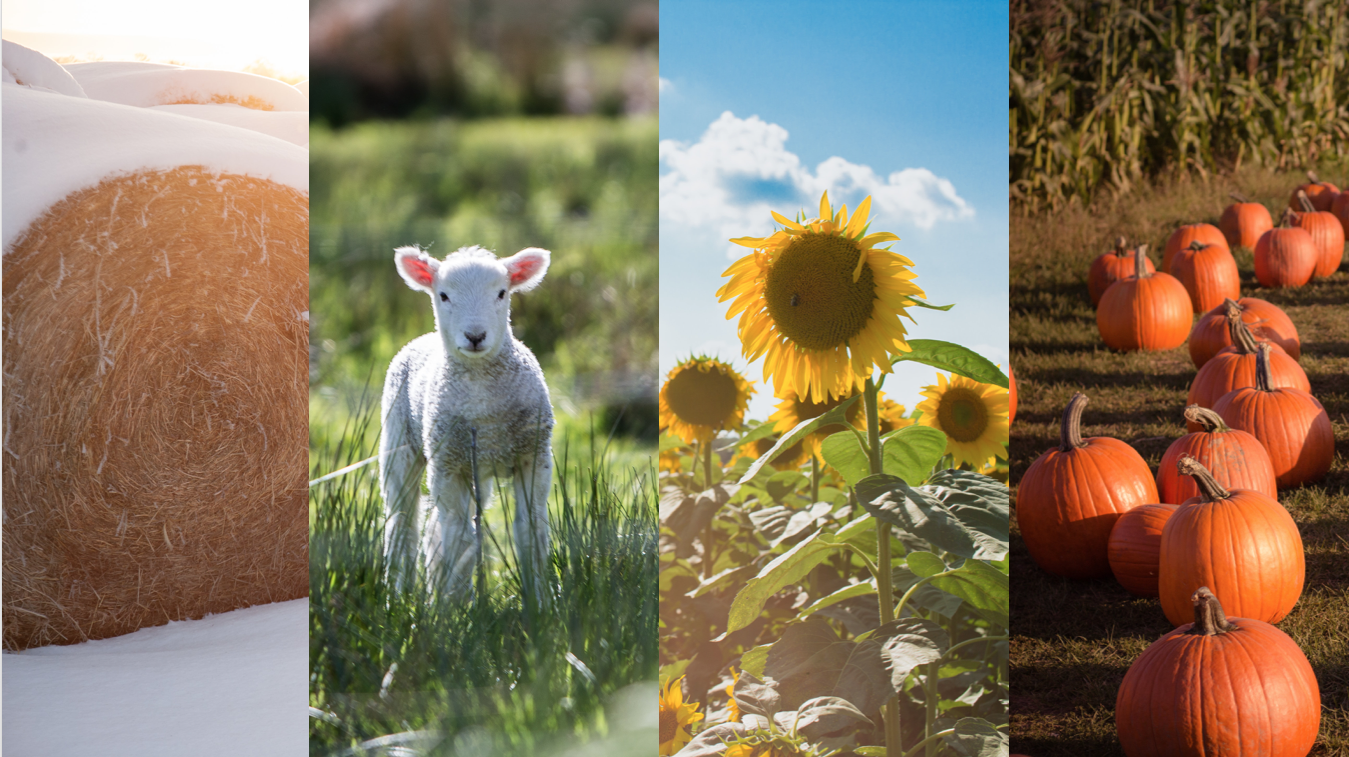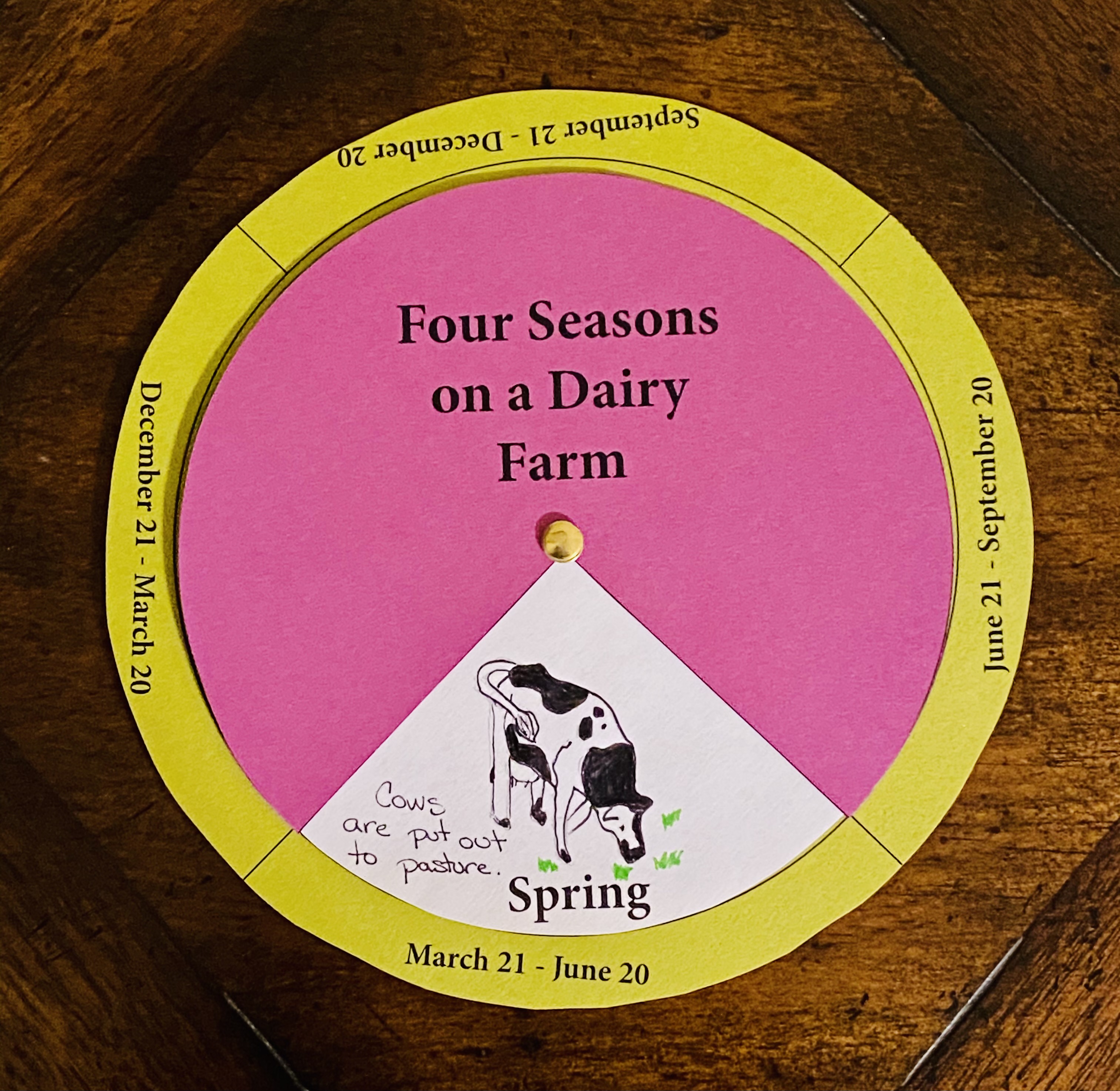Four Seasons on a Farm
Students identify the characteristics of the four seasons of the year, investigate what causes seasons, and observe the effects changing seasons have on farms.

Background
Lesson Activities
Recommended Companion Resources
Credits
Author
Lynn Wallin | National Center for Agricultural Literacy (NCAL)
Standards
Texas Content Area Standards
-
ELA: K.110.2.b.1
Developing and sustaining foundational language skills: listening, speaking, discussion, and thinking - - oral language. The student develops oral language through listening, speaking, and discussion.
- ELA: K.110.2.b.1.C: share information and ideas by speaking audibly and clearly using the conventions of language
- ELA: K.110.2.b.1.D: work collaboratively with others by following agreed-upon rules for discussion, including taking turns;
-
ELA: K.110.2.b.6
Response skills: listening, speaking, reading, writing, and thinking using multiple texts. The student responds to an increasingly challenging variety of sources that are read, heard, or viewed.
- ELA: K.110.2.b.6.F: respond using newly acquired vocabulary as appropriate
-
ELA: K.110.2.b.8
Multiple genres: listening, speaking, reading, writing, and thinking using multiple texts -- genres. The student recognizes and analyzes genre-specific characteristics, structures, and purposes within and across increasingly complex traditional, contemporary, classical, and diverse texts.
- ELA: K.110.2.b.8.B: discuss rhyme and rhythm in nursery rhymes and a variety of poems
-
ELA: 1.110.3.b.1
Developing and sustaining foundational language skills: listening, speaking, discussion, and thinking - - oral language. The student develops oral language through listening, speaking, and discussion.
- ELA: 1.110.3.b.1.C: share information and ideas about the topic under discussion, speaking clearly at an appropriate pace and using the conventions of language
- ELA: 1.110.3.b.1.D: work collaboratively with others by following agreed-upon rules for discussion, including listening to others, speaking when recognized, and making appropriate contributions
-
ELA: 1.110.3.b.7
Response skills: listening, speaking, reading, writing, and thinking using multiple texts. The student responds to an increasingly challenging variety of sources that are read, heard, or viewed.
- ELA: 1.110.3.b.7.F: respond using newly acquired vocabulary as appropriate
-
ELA: 1.110.3.b.12
Composition: listening, speaking, reading, writing, and thinking using multiple texts -- genres. The student uses genre characteristics and craft to compose multiple texts that are meaningful.
- ELA: 1.110.3.b.12.A: dictate or compose literary texts, including personal narratives and poetry
-
ELA: 2.110.4.b.1
Developing and sustaining foundational language skills: listening, speaking, discussion, and thinking -- oral language. The student develops oral language through listening, speaking, and discussion.
- ELA: 2.110.4.b.1.C: share information and ideas that focus on the topic under discussion, speaking clearly at an appropriate pace and using the conventions of language
- ELA: 2.110.4.b.1.D: work collaboratively with others by following agreed-upon rules for discussion, including listening to others, speaking when recognized, making appropriate contributions, and building on the ideas of others
-
ELA: 2.110.4.b.7
Response skills: listening, speaking, reading, writing, and thinking using multiple texts. The student responds to an increasingly challenging variety of sources that are read, heard, or viewed.
- ELA: 2.110.4.b.7.F: respond using newly acquired vocabulary as appropriate
-
ELA: 2.110.4.b.12
Composition: listening, speaking, reading, writing, and thinking using multiple texts -- genres. The student uses genre characteristics and craft to compose multiple texts that are meaningful.
- ELA: 2.110.4.b.12.A: compose literary texts, including personal narratives and poetry
-
Math: K.111.2.b.8
Data analysis. The student applies mathematical process standards to collect and organize data to make it useful for interpreting information.
- Math: K.111.2.b.8.A: collect, sort, and organize data into two or three categories
- Math: K.111.2.b.8.C: draw conclusions from real-object and picture graphs
-
Math: 1.111.3.b.8
Data analysis. The student applies mathematical process standards to organize data to make it useful for interpreting information and solving problems.
- Math: 1.111.3.b.8.B: use data to create picture and bar-type graphs
- Math: 1.111.3.b.8.C: draw conclusions and generate and answer questions using information from picture and bar-type graphs
-
Math: 2.111.4.b.10
Data analysis. The student applies mathematical process standards to organize data to make it useful for interpreting information and solving problems.
- Math: 2.111.4.b.10.B: organize a collection of data with up to four categories using pictographs and bar graphs with intervals of one or more
- Math: 2.111.4.b.10.D: draw conclusions and make predictions from information in a graph
-
Social Studies: 1.113.12.c.9
Economics. The student understands the value of work. The student is expected to:
- Social Studies: 1.113.12.c.9.B: describe how various jobs contribute to the production of goods and services
-
Social Studies: 2.113.13.c.16
Social studies skills. The student communicates in written, oral, and visual forms. The student is expected to:
- Social Studies: 2.113.13.c.16.E: communicate information visually, orally, or in writing based on knowledge and experiences in social studies
-
Social Studies: K.113.11.c.14
Social studies skills. The student communicates in oral and visual forms. The student is expected to:
- Social Studies: K.113.11.c.14.C: communicate information visually, orally, or in writing based on knowledge and experiences in social studies
- Social Studies: K.113.11.c.14.D: create and interpret visuals, including pictures and maps
-
Social Studies: 1.113.12.c.17
Social studies skills. The student communicates in oral, visual, and written forms. The student is expected to:
- Social Studies: 1.113.12.c.17.C: communicate information visually, orally, or in writing based on knowledge and experiences in social studies
- Social Studies: 1.113.12.c.17.D: create and interpret visual and written material
-
Science: 2.112.4.b.1
Scientific and engineering practices. The student asks questions, identifies problems, and plans and safely conducts classroom, laboratory, and field investigations to answer questions, explain phenomena, or design solutions using appropriate tools and models. The student is expected to:
- Science: 2.112.4.b.1.A: ask questions and define problems based on observations or information from text, phenomena, models, or investigations
- Science: 2.112.4.b.1.E: collect observations and measurements as evidence
- Science: 2.112.4.b.1.F: record and organize data using pictures, numbers, words, symbols, and simple graphs
-
Science: K.112.2.b.1
Scientific and engineering practices. The student asks questions, identifies problems, and plans and safely conducts classroom, laboratory, and field investigations to answer questions, explain phenomena, or design solutions using appropriate tools and models. The student is expected to:
- Science: K.112.2.b.1.A: ask questions and define problems based on observations or information from text, phenomena, models, or investigations.
- Science: K.112.2.b.1.E: collect observations and measurements as evidence.
- Science: K.112.2.b.1.F: record and organize data using pictures, numbers, words, symbols, and simple graphs.
-
Science: K.112.2.b.5
Recurring themes and concepts. The student uses recurring themes and concepts to make connections across disciplines. The student is expected to:
- Science: K.112.2.b.5.G: describe how factors or conditions can cause objects, organisms, and systems to either change or stay the same.
-
Science: K.112.2.b.10
Earth and space. The student knows that the natural world includes earth materials and systems that can be observed. The student is expected to:
- Science: K.112.2.b.10.B: observe and describe weather changes from day to day and over seasons.
-
Science: 1.112.3.b.1
Scientific and engineering practices. The student asks questions, identifies problems, and plans and safely conducts classroom, laboratory, and field investigations to answer questions, explain phenomena, or design solutions using appropriate tools and models. The student is expected to:
- Science: 1.112.3.b.1.A: ask questions and define problems based on observations or information from text, phenomena, models, or investigations.
- Science: 1.112.3.b.1.E: collect observations and measurements as evidence.
- Science: 1.112.3.b.1.F: record and organize data using pictures, numbers, words, symbols, and simple graphs.
-
Science: 1.112.3.b.5
Recurring themes and concepts. The student uses recurring themes and concepts to make connections across disciplines. The student is expected to:
- Science: 1.112.3.b.5.G: describe how factors or conditions can cause objects, organisms, and systems to either change or stay the same.
-
Science: 1.112.3.b.10
Earth and space. The student knows that the natural world includes earth materials that can be observed in systems and processes. The student is expected to:
- Science: 1.112.3.b.10.D: describe and record observable characteristics of weather, including hot or cold, clear or cloudy, calm or windy, and rainy or icy, and explain the impact of weather on daily choices.
-
Science: 2.112.4.b.5
Recurring themes and concepts. The student uses recurring themes and concepts to make connections across disciplines. The student is expected to:
- Science: 2.112.4.b.5.G: describe how factors or conditions can cause objects, organisms, and systems to either change or stay the same
-
Science: 2.112.4.b.10
Earth and space. The student knows that the natural world includes earth materials that can be observed in systems and processes. The student is expected to:
- Science: 2.112.4.b.10.B: measure, record, and graph weather information, including temperature and precipitation

 student with the three printouts of the
student with the three printouts of the